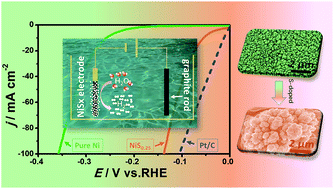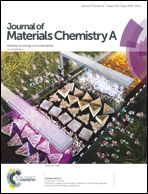Facile electrodeposition of cauliflower-like S-doped nickel microsphere films as highly active catalysts for electrochemical hydrogen evolution†
Abstract
The development of low-cost, earth-abundant, and high-efficiency catalysts for electrocatalytic water splitting is central to developing sustainable and clean energy. The abundant reserves of nickel sulfides are promising noble metal-free materials for the hydrogen evolution reaction (HER). In this work, a highly active cauliflower-like S-doped nickel microsphere film directly grown on a copper wire (CW) substrate (labeled as NiSx/CW) was facilely prepared via a one-step electrodeposition approach in a choline chloride/ethylene glycol (ethaline)-based deep eutectic solvent. Doping of S is found to induce an interesting structural transition from nanosheets to porous cauliflower-like microspheres, electronic structure changes at the surface, and a significant improvement in the HER catalytic performance. The as-prepared NiS0.25/CW with a Ni/S atomic ratio of 1 : 0.25 exhibits the best performance, showing a negligible onset potential (−18 mV) with a low overpotential (−54 mV at 10 mA cm−2) and small Tafel slope (54 mV dec−1) in 1.0 M KOH solution. Additionally, the NiS0.25/CW catalyst displays good durability and affords long-term electrolysis without activity degradation for 60 h. This study offers a facile synthesis route for in situ growth of the active phases on current collectors to fabricate self-supported noble-metal free HER catalysts and deep insights into the relationships among the S-doping, catalyst microstructure, and catalytic properties.



 Please wait while we load your content...
Please wait while we load your content...